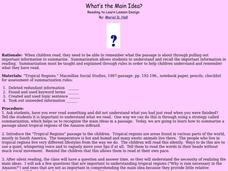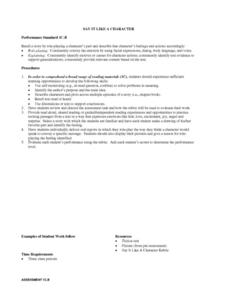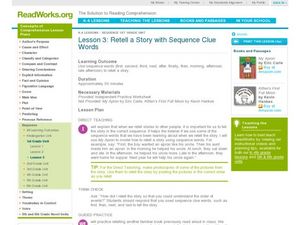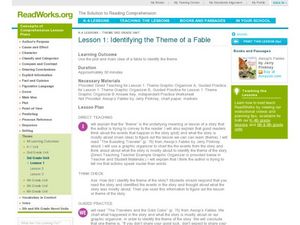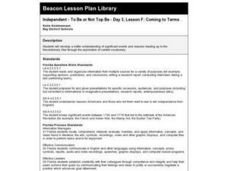EngageNY
Peer Critique and Revision: Editorial Essay
Get those red pens ready! Using the Peer Critique protocol, scholars provide and receive feedback on their editorial essay drafts. They then use class time to work on revisions.
iCivics
No Rambling Allowed
What makes for a strong persuasive argument? Organization! After deconstructing a sample argument and then following the guidelines of an included worksheet, your class members will learn how evidence can be organized in order to produce...
EngageNY
Solve for Unknown Angles—Angles and Lines at a Point
How do you solve for an unknown angle? In this sixth installment of a 36-part series, young mathematicians use concepts learned in middle school geometry to set up and solve linear equations to find angle measures.
Teach Engineering
Forms of Linear Equations
Linear equations are all about form. The fifth part in a unit of nine works with the different equivalent forms of linear equations. Class members become familiar with each form by identifying key aspects, graphing, and converting from...
EngageNY
Determining Discrete Probability Distributions 2
Investigate how long-run outcomes approach the calculated probability distribution. The 10th installment of a 21-part module continues work on probability distributions from the previous lesson. They pool class data to see how conducting...
EngageNY
Simplifying Square Roots
Explore the process of simplifying square roots through an analysis of perfect squares. The fourth lesson of 25 expects individuals to find the perfect square factors in each radicand as a means of simplifying. The perfect square factor...
Cornell University
Light Waves: Grades 9-12
Explore the behavior of light waves with a lab activity. Scholars build new vocabulary through experimentation and observation. Using different mediums, they model reflection, refraction, transmission, diffusion, and scattering of light.
Curated OER
At The Firehouse With Dad
Young scholars participate in a guided reading of the children's book "At The Firehouse With Dad" They improve reading comprehension skills with the use of independent practice. The students then answer discussion questions while reading...
Curated OER
Bibim Bap For Dinner
Young scholars participate in a literature analysis while reading the children's book "Bibim Bap For Dinner". The teacher performs a guided reading with the students while focusing on the skill of recognizing the main theme of the book....
Curated OER
Can you Top That?
Students make connections between their own experiences and the story, "get" the author's message and be able to discuss it with other readers, and apply their reading skills and strategies. They predict what happens in the story,...
Curated OER
Leo and the Butterflies
Second graders read a book entitled, "Leo and the Butterflies." They discuss the rainforest and butterflies. Students observe the pictures and predict what will happen in the story. They examine reading strategies for decoding unfamiliar...
Curated OER
Sunny or Shady?
Students practice answering questions to aid in creating meaning when reading. Through guided practice, they read a passage from the chapter book "Tuck Everlasting" and answer in-text and inference questions. Independently, they read...
Curated OER
Deep or Shallow
Third graders practice answering questions to aid in creating meaning when reading. Through guided practice, they read a passage from a chapter book and answer in-text and inference questions. Independently, they read another chapter...
Curated OER
What's the Main Idea?
Students summarize a piece of text. After reviewing the correct way to read and summarize, students work in groups to summarize a piece of text assigned by the instructor. They write a summary paragraph using the process outlined during...
Curated OER
Music from a Place Called Half Moon
Students read the novel, Music from a Place Called Half Moon. They are assigned chapters to analyze for literary elements and to assign titles to the book chapters.
Curated OER
Say It Like A Character
Young scholars read a story and retell it to the class by role-playing one of the characters. In groups, they use the correct facial expressions along with body language and voice to convince the others in their group that they are...
Curated OER
Reading/English Language Arts/ Instructional Strategies
Students are given a line drawing that only that students sees. They are asked to describe the drawings to the reset of the class to see if they can draw it as the teacher describes it. Students work with a partner, and they are given a...
Curated OER
Lesson 3: Retell a Story with Sequence Clue Words
First graders evaluate sequence words. In this order of events lesson plan, 1st graders practice using sequence words to retell a story. They do guided practice with the teacher retelling a story they have read as a class and then try it...
Curated OER
Humorous Solutions
Discover with your class the humorous solution that follows tall tales. Elementary learners will discuss the tall tale Paul Bunyan and give ordinary solutions for the problems in the story. They will read Sally Ann Thunder Ann Whirlwind...
Curated OER
Identifying Theme of a Fable
Third graders understand how to find the theme of a fable. In this theme lesson, 3rd graders use graphic organizers to record the events of a fable. Students use that information to determine the lesson of the story. Students do a guided...
Curated OER
Lesson 4: Fact and Opinion - Rosa Parks: My Story
Sixth graders examine implicit and explicit opinions in a text about Rosa Parks. In this explicit and implicit opinions lesson, 6th graders participate in direct teaching, guided practice, and independent practice while reading an...
Curated OER
Independent - To Be or Not Top Be - Day 3, Lesson F: Coming to Terms
Fifth graders develop vocabulary through the study of the American Revolution.
Curated OER
Independent - To Be or Not Top Be - Day 2, Lesson C: Freedom of Speech
Fifth graders explore the following questions: What is it? What is it like? What is an example?
Curated OER
Growing Seeds
In this science worksheet, students read 5 different scenarios with varied growing conditions for plants. Students make a prediction for each: Will it grow a little, grow a lot, or not grow at all?















